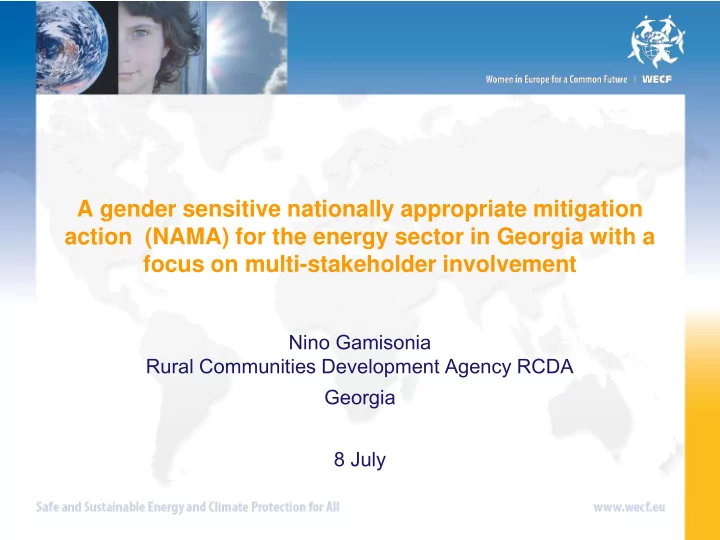

A gender sensitive nationally appropriate mitigation action (NAMA) for the energy sector in Georgia with a focus on multi-stakeholder involvement Nino Gamisonia Rural Communities Development Agency RCDA Georgia 8 July
Baseline situation Firewood is the main source of energy This impacts cts women and increases climate ate and environ ronme menta ntal l risks: Women ‘ s unpaid work burden for preparing fire , hot water - - Indoor air pollution: women and children health most affected - Erosion and landslides due to deforestation : accident risk - Climate impact : 1.44 million tons of CO2 emissions p/yr by 515.000 rural household and institutions (conservative estimation ) Heating 30% 70% Cooking spending other on fuel spending wood Hot water
Climate mitigation & economic results • 400 solar collectors constructed and installed in rural areas p/solar collector: reduction of 1000 kg CO2 • Much less spending energy, average 32% savings ngs on househ ehold ld budget et • BEFORE AFTER Firewoo wood (m3) use per 25.00 househol old/yea /year 20.00 15.00 10.00 Costs s for fuel (GEL) EL) 5.00 4000.00 /hh/y /year ear 3000.00 0.00 Khoni Sagaredjo Khobi Mtskheta Akhaltsikhe 2000.00 1000.00 0.00
Gender Equality: lessons learnt Traditional Gender labour division: specific skills for construction only men • Often in construction and infrastructure projects, only men are employed • In this pilot phase, gender r equality ity was aimed d for in trainings on construction, • maintenance and monitoring (MRV) – 40% was achieved To ensure parity, women were encouraged to become maintenance and • monitoring experts – successful strategy !
Benefits for women: lessons learnt Women en benefit efitted ted most t from SWH installed at their home: • reduced unpaid domestic work burden ! • greater hot water availability for washing, cooking, hygiene Women en were majori rity ty of people ple wanting ng to invest in SWH • Women were mostly unable to obtain credit from bank for SWH • A lease-purchase financial scheme contracted 80% women – bring to scale! Women en excel ellent ent as monitor and maintenance experts SWH • Trained women were reliably monitors, able to gain additional income • Women were reliable in using and maintaining SWH properly • Women great promoters of the technology
Benefits for men: lessons learnt Men benefitt fitted ed from SWH installed at their home: • reduced unpaid domestic work burden ! • Time and hygiene Men also want to invest in SWH • It gives them something meaningful to do Men excellent llent construction struction experts SWH • Trained men were reliable constructors, able to gain additional income
Special features of Gender-equitable NAMA • Construction, installation and maintenance of 11.500 Fuel Efficient Stoves (50% less wood) , 11.500 Solar Water Heaters and 11.500 Energy Efficient Insulation Measures • All technologies using local materials produced in community based technology production units • Sustainable forest management to ensure remaining biomass is carbon neutral • Capacity building and jobs for women (50%) and men (50%) • Creation of a financial mechanism to provide credits at reasonable interest rates (aim is 8% p/yr instead of 20-30% which is common) A special ‘ window ’ / instrument to allow access to credit for • women in vulnerable situations.
Social Co-benefits Impr proved oved living ing standa andards ds because increased availability of heat • and comfort, energy needs are met, improving the status of rural life; Reduced duced labor bor burd rden for women, as they are responsible for • keeping the house warm, and for men as they are responsible for bringing and chopping firewood. Incr creased eased gender nder equali uality ty due to awareness raising and • empowering women to play key roles in the local implementation of the NSP (Nama support project)
Economic co-bennefits Reduc duced ed rura ural pove verty y by decreas creasing ing ener ergy gy costs. sts. Beneficiary • households have to buy less firewood, gas and electricity and save around 30% of total energy costs. • 135 Jobs created in areas of: administration, monitoring ( more women ) construction, installation ( more men ) and training & maintenance ( women & men ) Enhan anced ced econ onomic omic deve velopm lopment ent and stren engt gthe hened ned priva ivate te • sec ector or by attracting investments in rural areas. Also the input suppliers will experience growth of their businesses Reduced duced national ional energy ergy dependenc pendency as also gas and • electricity use will be reduced
Environmental co-benefits Save 120 m3 of wood per year by 2021, avoiding oiding ove vercut rcuttin ting of • fore rests sts redu duced ced expo posure sure to in indoor door air polluti ution on • Prot otection ection of biodiv divers ersity ty due to improved forest management • and habitat conservation
Stakeholder engagement • Broad stakeholder engagement can draw out barriers to implementation and ensure co-benefits are properly assessed • Stakeholders are engaged at every stage of preparation of NAMA: • Developing multi-level, multi stakeholder governance framework • Preparation of climate change profiles and vulnerability scenarios • Identification of strategic mitigation and adaptation options leading to low emission, climate resilient development • Prioritization of strategic options through technological, social, financial feasibility and cost-benefit analyses
Lessons for Lima Gender Action Plan Technology is not gender neutral ! • Needed: local women and men ’ s participation in ex-ante assessments of cost, risk, gender impacts and benefits • Assess various options and pathways, including existing traditional and endogenous technologies • Co-benefits are key for sustainability: gender equality, local jobs and poverty reduction, environmental protection – set criteria! • Parity in participation of women and men in design and adaptation of technologies • Parity in capacity building, construction, operation & monitoring • Financing mechanism for technology - ensure access for women in vulnerable situations to grants and credits • Implement CEDAW and SDG Goal 5 to ensure no more barriers to gender equality
THANK YOU! Contact: ngamisonia@gmail.com wecf@wecf.eu
Recommend
More recommend